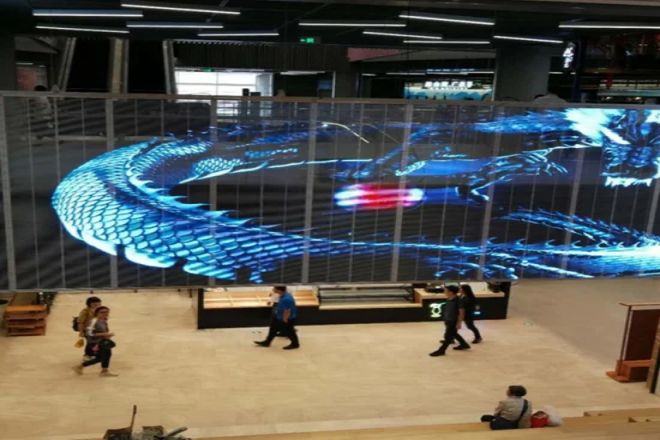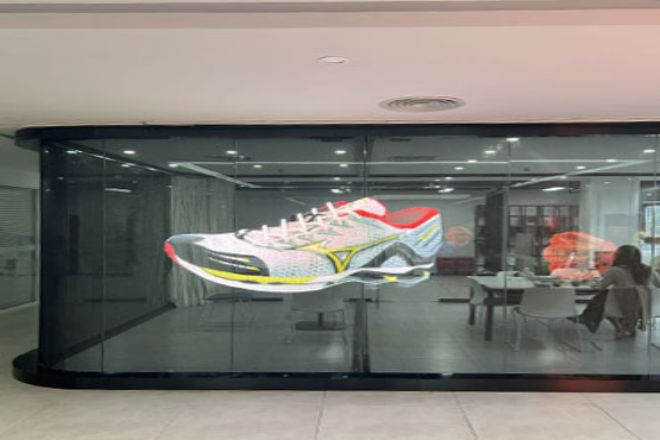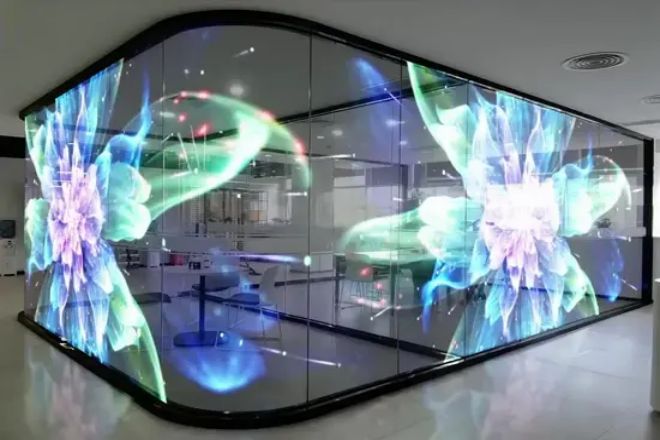مقدمة

في عالم اليوم الذي يتميز بالتطور التكنولوجي السريع، تتطور تقنية العرض، باعتبارها الجسر الذي يربط بين العالمين الحقيقي والافتراضي، بسرعة غير مسبوقة.
من الشاشة الأولى بالأبيض والأسود إلى شاشة LCD الملونة، وصولًا إلى تقنيات اليوم المتقدمة مثل OLED وMini LED، أثرت كل قفزة في تجربتنا البصرية بشكل كبير. واليوم، تُعدّ تقنية العرض ثلاثية الأبعاد جوهرة الجيل الجديد من تقنيات العرض. شاشة LED شفافة تغير بهدوء فهمنا لكلمة "عرض".
فهو لا يكسر القيود ثنائية الأبعاد لشاشات العرض التقليدية فحسب، بل يفتح أيضًا عصرًا بصريًا جديدًا لنا بشفافيته الفريدة وإحساسه ثلاثي الأبعاد.
في هذا العصر المليء بالإمكانيات اللانهائية، دعونا ننطلق في رحلة الاستكشاف البصري هذه معًا، وفي دقيقتين فقط، نكشف سر شاشة العرض LED الشفافة ثلاثية الأبعاد ونشعر بالصدمة البصرية غير المسبوقة والإلهام الإبداعي الذي تجلبه.
1. نظرة عامة على شاشة العرض LED الشفافة ثلاثية الأبعاد
كما يوحي الاسم، ثلاثي الأبعاد شاشة العرض LED الشفافة هي شاشة عرض تجمع بين تقنية العرض LED والتصميم المبتكر للمواد الشفافة.
فهو لا يرث فقط المزايا التقليدية لشاشات العرض LED، مثل السطوع العالي والتباين العالي والعمر الطويل والألوان الزاهية، بل يحقق أيضًا شفافية الشاشة نفسها باستخدام مواد خاصة مثل الركائز الشفافة.
يتيح هذا التصميم للشاشة السماح للمناظر الخلفية أو الضوء بالتغلغل بشكل طبيعي أثناء تشغيل المحتوى، مما يخلق شعوراً غير مسبوق بالتسلسل البصري والمساحة، وبالتالي تحقيق مزيج حقيقي من "الشفافية" وتأثيرات "ثلاثية الأبعاد".
السمات الهيكلية:
- حبات مصباح LED:
كوحدة إضاءة للشاشة، تستخدم شاشة LED الشفافة ثلاثية الأبعاد حبيبات مصباح LED دقيقة عالية الكثافة. تتميز هذه الحبيبات بحجمها الصغير وسطوعها العالي، كما يمكنها التحكم بدقة في تشغيل وإيقاف كل بكسل، مما يضمن عرضًا دقيقًا للصور.
وفي الوقت نفسه، من أجل الحفاظ على الشفافية، يجب تصميم تخطيط وترتيب حبات المصباح بعناية للتأكد من أنها لا تحجب الكثير من الضوء عند إصدار الضوء.
- الركيزة الشفافة:
تُعدّ الطبقة الشفافة أحد المكونات الأساسية لشاشة LED الشفافة ثلاثية الأبعاد. وعادةً ما تُصنع من الزجاج أو مواد بلاستيكية خاصة ذات نفاذية ضوئية عالية.
لا تتمتع هذه الركيزة بخصائص ميكانيكية جيدة واستقرار فحسب، بل الأهم من ذلك أنها تسمح للضوء بالتغلغل بحرية بحيث يمكن عرض المشهد أو الضوء خلف الشاشة بوضوح.
من خلال تحسين مادة الركيزة وبنيتها، يمكن تحسين الشفافية والتأثير البصري للشاشة بشكل أكبر.
- دائرة التحكم:
دائرة التحكم هي جوهر شاشة LED الشفافة ثلاثية الأبعاد. وهي مسؤولة عن استقبال ومعالجة الإشارات من مصادر خارجية (مثل أجهزة الكمبيوتر والهواتف المحمولة، إلخ)، وتحويل هذه المعلومات إلى تعليمات لتشغيل وإيقاف مصابيح LED.
لتحقيق تأثيرات عرض عالية الدقة وسلسة، يجب أن تتمتع دائرة التحكم بقدرات معالجة بيانات عالية السرعة وتحكم دقيق في البكسل. وفي الوقت نفسه، وللحفاظ على الشفافية والجمالية، عادةً ما تكون دائرة التحكم رقيقة ومخفية تحت طبقة شفافة.
2. أبرز التقنيات الأساسية

- تأثير العرض ثلاثي الأبعاد
يُعد تأثير العرض ثلاثي الأبعاد لشاشة LED الشفافة ثلاثية الأبعاد من أبرز مزاياها التقنية الأساسية. ولتحقيق هذا التأثير، تستخدم الشاشة تصميمًا بصريًا متطورًا وخوارزميات برمجية متقدمة.
من حيث التصميم البصري، من خلال ضبط كثافة الترتيب والزاوية والانكسار ومسار الانعكاس لخرزات مصباح LED، يمكن للشاشة تقديم إحساس ثلاثي الأبعاد غني بالطبقات والعمق عند تشغيل محتوى ثلاثي الأبعاد.
وفي الوقت نفسه، يمكن تعزيز التأثير البصري المجسم بشكل أكبر من خلال الجمع بين عدسة خاصة أو تقنية شبكية، مما يسمح للجمهور بالشعور وكأنهم منغمسون في الصورة.
من حيث خوارزميات البرمجيات، تستخدم شاشات العرض LED الشفافة ثلاثية الأبعاد تقنية معالجة الصور المتقدمة لتحليل الصور الأصلية ومعالجتها بعمق، واستخراج المعلومات ثلاثية الأبعاد في الصور، وتحويلها إلى تنسيق مناسب لعرض الشاشة.
من خلال تحسين الخوارزمية، يمكن ضمان عرض الصورة بتأثير ثلاثي الأبعاد أكثر واقعية وطبيعية مع الحفاظ على وضوح عالٍ. هذا المزيج من البرامج والأجهزة يمنح شاشات العرض LED الشفافة ثلاثية الأبعاد ميزة فريدة في عرض المشاهد المعقدة والمحتوى الديناميكي.
- شفافية عالية ونفاذية للضوء
تُعد الشفافية العالية ونفاذية الضوء من أهم المزايا التقنية لشاشات العرض LED الشفافة ثلاثية الأبعاد. ولتحقيق هذا الهدف، بذلت شاشات العرض جهودًا كبيرة في اختيار وتجهيز مواد الركيزة الشفافة.
أولاً، يجب أن تتمتع مادة الركيزة بنفاذية ضوء جيدة لضمان نفاذ الضوء بسلاسة عبر الشاشة. من بين مواد الركيزة الشفافة الشائعة الاستخدام في السوق: الزجاج عالي النفاذية الضوئية، والبلاستيك الخاص، وغيرها.
لا تتمتع هذه المواد بنفاذية عالية للضوء فحسب، بل تتمتع أيضًا بخصائص ميكانيكية جيدة واستقرار، مما يمكنها من تلبية متطلبات استخدام شاشة العرض.
ثانياً، فيما يتعلق بتكنولوجيا معالجة المواد الأساسية، يتم أيضًا استخدام مجموعة متنوعة من الأساليب لتحسين الشفافية.
على سبيل المثال، من خلال تحسين عملية معالجة السطح، يمكن تقليل انعكاس وتشتت سطح الركيزة، وبالتالي تحسين نفاذية الضوء؛ أو من خلال استخدام تقنية تراكب الأغشية الرقيقة متعددة الطبقات، يمكن استخدام الفرق في معامل الانكسار بين المواد المختلفة لتعزيز تأثير نفاذية الضوء.
يتيح تطبيق هذه الوسائل التقنية لشاشة LED الشفافة ثلاثية الأبعاد تحقيق تأثيرات بصرية جيدة وإعادة إنتاج الألوان مع الحفاظ على الشفافية العالية.
- التخصيص والتثبيت المرن
يُعد التصميم المعياري لشاشة LED الشفافة ثلاثية الأبعاد مفتاحًا لمرونة تخصيصها وتركيبها. تتكون الشاشة من عدة وحدات مستقلة، تحتوي كل منها على عدد محدد من مصابيح LED ودوائر التحكم.
يتيح هذا التصميم إمكانية ربط الشاشة ودمجها بشكل مرن وفقًا للاحتياجات الفعلية للتكيف مع بيئات التثبيت ذات الأشكال والأحجام المختلفة.
بالإضافة إلى ذلك، يوفر التصميم المعياري أيضًا العديد من وسائل الراحة.
على سبيل المثال، أثناء عملية التثبيت، يمكن تعديل موضع وعدد الوحدات بمرونة وفقًا للظروف الموجودة في الموقع لتحقيق أفضل تأثير بصري وتأثير تثبيت؛ أثناء الصيانة، إذا فشلت وحدة أو تعرضت للتلف، فيمكن إزالة الوحدة واستبدالها بشكل منفصل دون التأثير على التشغيل الطبيعي للشاشة بأكملها.
إن هذه المرونة وسهولة الصيانة تجعل شاشة LED الشفافة ثلاثية الأبعاد تتمتع بآفاق تطبيق واسعة في الشاشات التجارية واسعة النطاق ومنشآت الفن العام وغيرها من المجالات.
3. عرض سيناريو التطبيق
- الإعلانات التجارية
في المجال التجاري، أصبحت شاشات العرض LED الشفافة ثلاثية الأبعاد تدريجيًا هي المفضلة الجديدة لمراكز التسوق الكبرى والمطارات وغيرها من المناطق المزدحمة، ولديها تأثيرات بصرية فريدة وجاذبية قوية.
لا تستطيع شاشات العرض هذه عرض محتوى إعلاني عالي الدقة وحيوي فحسب، بل والأهم من ذلك، أنها تستطيع استخدام خصائصها الشفافة لدمج معلومات الإعلان مع البيئة أو المناظر الطبيعية خلفها، مما يخلق تأثيرًا بصريًا غير مسبوق.
عندما يتنقل العملاء عبر هذه المناطق، سوف ينجذبون إلى الصور الرائعة على هذه الشاشات، وسيتوقفون ويشاهدون بشكل لا إرادي، وبالتالي تحسين تأثير الاتصال وصورة العلامة التجارية للإعلان بشكل فعال.
بالإضافة إلى ذلك، تدعم شاشات العرض LED الشفافة ثلاثية الأبعاد أيضًا تحديثات المحتوى الديناميكي والتحكم عن بعد، مما يسمح للمعلنين بتعديل محتوى الإعلان بمرونة وفقًا لطلب السوق والأجواء الاحتفالية والحفاظ على الإعلان جديدًا وفي الوقت المناسب.
- المعارض الفنية
في مجال الثقافة والفنون، تُبرز شاشات العرض LED الشفافة ثلاثية الأبعاد سحرها الاستثنائي. ففي قاعات العرض، كالمتاحف والمعارض الفنية، تُدمج هذه الشاشات بذكاء في عرض الأعمال الفنية، لتُشكّل جسرًا يربط بين الأصالة والمعاصرة، والواقع والافتراضية.
من خلال التلاعب بالصور الديناميكية والخلفيات التاريخية والعمليات الإبداعية المتعلقة بالأعمال الفنية، يمكن للمشاهدين اكتساب فهم وتجربة أشمل وأعمق أثناء تقدير الأعمال الفنية. والأهم من ذلك، أن تفاعلية شاشات LED الشفافة ثلاثية الأبعاد تُقدم أسلوبًا جديدًا لتجربة المعارض الفنية.
ويستطيع الجمهور التفاعل مع الشاشة من خلال شاشات اللمس، والتعرف على الإيماءات، وغيرها من الطرق، والمشاركة في إنشاء الأعمال الفنية وعرضها، والاستمتاع بالمشاركة والانغماس غير المسبوقين.
- المنزل الذكي
مع انتشار مفهوم المنازل الذكية والتقدم المستمر للتكنولوجيا، بدأت شاشات LED الشفافة ثلاثية الأبعاد أيضًا في إظهار آفاق تطبيقها الواسعة في مجالات مثل الديكور المنزلي والنوافذ الزجاجية الذكية.
فيما يتعلق بديكور المنزل، يمكن تصميم هذه الشاشات بأشكال وأحجام متنوعة، ودمجها في الجدران والأسقف والأثاث كجزء من الديكور الداخلي. فهي لا تقتصر على تشغيل الموسيقى والفيديوهات وغيرها من المحتوى الذي يعجب أفراد العائلة فحسب، بل تضبط أيضًا السطوع واللون تلقائيًا وفقًا للإضاءة المحيطة والجو العام، لخلق بيئة معيشية دافئة ومريحة.
فيما يتعلق بالنوافذ الزجاجية الذكية، يمكن دمج شاشات LED الشفافة ثلاثية الأبعاد مع أنظمة التحكم الذكية لتحقيق وظائف الفتح والإغلاق الذكي، والحماية من الشمس، والعزل الحراري، وغيرها من وظائف النوافذ. كما يمكن استخدامها كمنصة لعرض المعلومات العملية، مثل توقعات الطقس، والوقت والتاريخ، ومعلومات السلامة المنزلية، مما يوفر الراحة والرفاهية لحياة الأسرة.
ولا تعمل هذه التطبيقات على تحسين جودة المعيشة فحسب، بل تُظهر أيضًا الإمكانات غير المحدودة لشاشات LED الشفافة ثلاثية الأبعاد كجزء من مساحات المعيشة المستقبلية.
4. المزايا والتحديات التقنية

1) المزايا التقنية
- تأثيرات بصرية ممتازة:
تحقق شاشات LED الشفافة ثلاثية الأبعاد تجربة بصرية ثلاثية الأبعاد من خلال التصميم البصري المتطور وخوارزميات البرامج، مما يسمح للمشاهدين بتجربة تأثيرات صور أكثر واقعية وحيوية.
لا يعمل تأثير العرض الفريد هذا على تعزيز التأثير البصري فحسب، بل يعزز أيضًا شعور الجمهور بالانغماس والمشاركة، مما يجلب طريقة عرض جديدة للإعلانات التجارية والمعارض الفنية وغيرها من المجالات.
- توفير الطاقة وحماية البيئة:
بالمقارنة مع الشاشات التقليدية، تتمتع شاشات LED الشفافة ثلاثية الأبعاد بمزايا كبيرة في استهلاك الطاقة.
بفضل استخدام مصادر ضوء LED عالية الكفاءة وتصميم الدوائر الأمثل، يمكن لهذه الشاشات تقليل استهلاك الطاقة بشكل كبير وتقليل التأثير على البيئة مع الحفاظ على السطوع العالي والوضوح العالي.
علاوة على ذلك، تسمح خصائصها الشفافة أيضًا للشاشة بالسماح للضوء بالمرور عندما لا تكون هناك حاجة لعرض المحتوى، مما يقلل من استهلاك الطاقة بشكل أكبر.
- تركيب مريح:
التصميم المعياري لشاشة LED الشفافة ثلاثية الأبعاد يجعل عملية التركيب أكثر مرونة وراحة. يمكن للمستخدمين اختيار أعداد وأحجام مختلفة من الوحدات للتوصيل والدمج وفقًا للاحتياجات الفعلية، للتكيف مع بيئات التركيب بمختلف الأشكال والأحجام.
وفي الوقت نفسه، يعد هذا التصميم مناسبًا أيضًا لأعمال الصيانة والاستبدال اللاحقة، مما يقلل من تكاليف الصيانة وتكاليف الوقت.
2) التحديات
- نضج التكنولوجيا:
على الرغم من أن شاشات العرض LED الشفافة ثلاثية الأبعاد تتمتع بمزايا كبيرة في التأثيرات البصرية والأداء الفني، إلا أن نضجها التكنولوجي لا يزال بحاجة إلى التحسين.
في الوقت الحالي، يوجد عدد قليل نسبيًا من الشركات في السوق التي توفر شاشات عرض LED ثلاثية الأبعاد شفافة وعالية الجودة، ولم يتم توحيد المعايير والمواصفات الفنية بشكل كامل بعد، مما حدّ إلى حد ما من نطاق الترويج لهذه التقنية وتطبيقها.
- التحكم في التكاليف:
نظراً لاستخدام شاشات عرض LED الشفافة ثلاثية الأبعاد مواد عالية الجودة وعمليات تقنية متطورة، فإن تكلفتها مرتفعة نسبياً. قد يُمثل هذا تحدياً كبيراً لبعض المستخدمين ذوي الميزانيات المحدودة. لذلك، يُعدّ خفض التكاليف مع ضمان الجودة من أهم القضايا التي يجب حلها لتطوير هذه التقنية مستقبلاً.
- إنشاء المحتوى:
إن تأثير شاشات العرض LED الشفافة ثلاثية الأبعاد يفرض متطلبات أعلى على إنتاج المحتوى. ولإبراز مزاياها البصرية المجسمة، يجب إنتاج محتوى ثلاثي الأبعاد عالي الجودة والوضوح.
مع ذلك، هناك عدد قليل نسبيًا من المؤسسات والكفاءات المهنية القادرة على توفير هذا المحتوى في السوق، كما أن تكلفة إنتاجه مرتفعة نسبيًا. وهذا ما حدّ إلى حدٍّ ما من تطبيق هذه التقنية وتطويرها في بعض المجالات.
3) اتجاهات وحلول التطوير المستقبلية
مع التقدم المستمر للتكنولوجيا والتطوير المستمر للسوق، فإن آفاق التطوير المستقبلية لشاشات العرض LED الشفافة ثلاثية الأبعاد واسعة.
ولكي نتمكن من التغلب على التحديات المذكورة أعلاه وتحقيق التطبيق والتطوير على نطاق أوسع، يمكننا أن ننطلق من الجوانب التالية:
- تعزيز البحث والتطوير التكنولوجي وبناء المعايير:
تعزيز النضج والتحسين المستمر لتقنية شاشات LED الشفافة ثلاثية الأبعاد من خلال زيادة الاستثمار في البحث والتطوير والابتكار التكنولوجي. وفي الوقت نفسه، تعزيز بناء المعايير في هذه الصناعة، وصياغة معايير ومواصفات تقنية موحدة، وتحسين توافق المنتجات وقابليتها للتبادل.
- تحسين هيكل التكلفة:
تخفيض تكاليف الإنتاج من خلال الإنتاج على نطاق واسع، وتحسين عمليات الإنتاج، واختيار المواد.
وفي الوقت نفسه، ينبغي تعزيز التعاون والتشاور مع الموردين والشركاء سعياً إلى الحصول على أسعار شراء أكثر ملاءمة وإدارة سلسلة التوريد بشكل أكثر كفاءة.
- تعزيز تطوير صناعة إنشاء المحتوى:
تشجيع ودعم المؤسسات والمواهب المهنية على تكريس جهودها لتطوير وابتكار محتوى ثلاثي الأبعاد. وتحفيز الإبداع والارتقاء به من خلال توفير الدعم السياسي والمالي والتوجيه التدريبي.
وفي الوقت نفسه، ينبغي تعزيز التعاون والتبادلات مع الصناعات ذات الصلة مثل صناعة السينما والتلفزيون والألعاب والإعلان، والعمل بشكل مشترك على تعزيز ازدهار وتنمية صناعة إنشاء المحتوى ثلاثي الأبعاد.
خاتمة
مع النضج المستمر وانتشار تقنية شاشات LED الشفافة ثلاثية الأبعاد، لدينا ما يدعونا للاعتقاد بأن عالم المستقبل المرئي سيكون أكثر حيويةً وإشراقًا وإثارةً للاهتمام. فهي ليست رمزًا للتقدم التكنولوجي فحسب، بل هي أيضًا تجسيدٌ للإبداع والخيال البشري. على هذا المسرح الخيالي، المتشابك بين الضوء والظل، تتألق كل تفصيلة بنور الحكمة، وكل ابتكار يُبشّر بمستقبل أفضل.
أخيرًا، إذا كنت تريد معرفة المزيد عن شاشات LED، يرجى الحصول على اتصال معنا.
